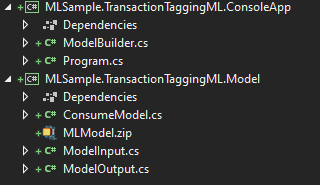

AutoML powers experiences like those found in Model Builder and the ML.NET CLI. Automated machine learning (AutoML) improvementsĪutomated machine learning (AutoML) automates the process of applying machine learning to data.
#Ml.net model builder install#
To get started with tokenizers, install and reference the Microsoft.ML.Tokenizers NuGet package inside your. In this example, the vocabulary used for encoding is for the GPT-2 model so that’s the one you’d use.ĭecoding the tokens converts them back to a string. Once your text data is tokenized you can use it as input for your model. The encoded results provide information such as Ids which map to the index of that word in the vocabulary file as well as offsets which indicate the positions where each of the tokens starts and ends. Tokenizer.Decode(tokenizerEncodedResult.Ids) Var tokenizerEncodedResult = tokenizer.Encode(input) Var input = "the brown fox jumped over the lazy dog!" Var tokenizer = new Tokenizer(new Bpe(vocabFilePath, mergeFilePath),RobertaPreTokenizer.Instance) Var vocabFilePath = mergeFilePath = Initialize Tokenizer This sample uses vocabulary resources from the HuggingFace GPT-2 repository. You can use the APIs provided in that package to import custom vocabularies and use the BPE tokenizer to process text data.

We then decided to publish the tokenization APIs inside of ML.NET in the Microsoft.ML.Tokenizers NuGet package. We implemented a tokenizer for the English Roberta model which uses the Byte-Pair Encoding algorithm to satisfy the NAS-BERT model requirements. This is often done using tokenization techniques. To enable Natural Language Processing scenarios like Text Classification and Sentence Similarity, we needed a way to process text data. After training the model, you can provide source and target sentences and the model will predict the similarity between them.įor a more detailed example of the Sentence Similarity API, see the ML.NET 2.0 samples. To train a sentence similarity model, add the SentenceSimilarity trainer to your pipeline and call Fit. Similarity is defined by the value in the “Similarity” column which is a scale between 1 and 5 where 1 is least similar and 5 is most similar. In this example, a model is trained using sentences like “ML.NET 2.0 just released”, “There’s a new version of ML.NET”, and “The rain in Spain stays mainly in the plain” with the goal of predicting their similarity. The main difference though is instead of predicting a category, the model calculates a numerical value that represents how similar two phrases are. This API uses the same underlying TorchSharp NAS-BERT model as the Text Classification API. With ML.NET 2.0 we’ve also introduced a new API for sentence similarity. To get started with the Text Classification scenario, follow the sentiment analysis tutorial. For more details on setting up your GPU, see the ML.NET GPU guide. For GPUs you need a CUDA-compatible GPU and we recommend at least 6 GB of dedicated memory.

This scenario supports local training on both CPU and GPU. With this new scenario, you can train custom text classification models using the latest deep learning techniques from Microsoft Research inside of Model Builder. Today we’re excited to announce the Text Classification scenario in Model Builder powered by the ML.NET Text Classification API. Since then, we’ve been working on refining the API. Using a pre-trained version of this model, the Text Classification API uses your data to fine-tune the model. It does so by integrating a TorchSharp implementation of NAS-BERT into ML.NET. As the name implies, this API enables you to train custom models that classify raw text data. Text Classification scenario in Model BuilderĪ few months ago we released a preview of the Text Classification API.
#Ml.net model builder upgrade#
To get started with these new features, install or upgrade to the latest versions of the ML.NET 2.0.0 and 0.20.0 packages as well as Model Builder 16.4.0 or later. You can find a list of all the changes in the respective ML.NET and Model Builder release notes. The following are highlights from this release. ML.NET version 2.0 and a new version of Model Builder are now released! What’s new? NET developers that enables integration of custom machine learning models into. ML.NET is an open-source, cross-platform machine learning framework for.


 0 kommentar(er)
0 kommentar(er)
